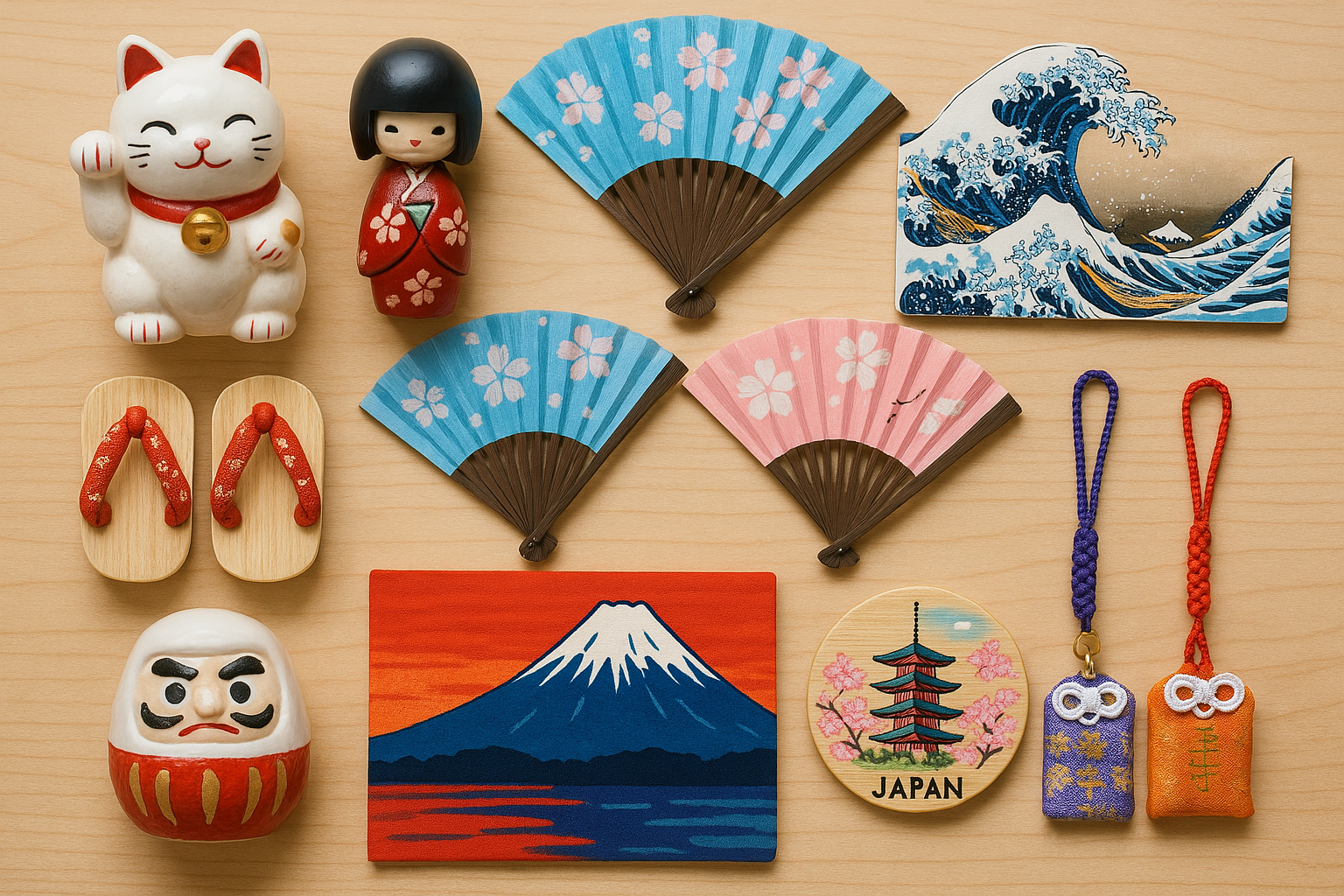- Introduction: Why Traditional Japanese Souvenirs Are the Best Gifts
- Top Traditional Japanese Souvenirs You Must Buy
- Where to Shop for Authentic Traditional Japanese Souvenirs
- How to Choose the Perfect Traditional Japanese Souvenir for Your Friends and Family
- Conclusion: Bringing a Piece of Japan Home with You
Introduction: Why Traditional Japanese Souvenirs Are the Best Gifts
When traveling to Japan, the search for the perfect souvenir is almost as important as the destination itself. From the bustling streets of Tokyo to the serene temples of Kyoto, Japanese souvenirs are not just items—they’re memories waiting to be taken home. These traditional keepsakes carry with them centuries of craftsmanship, culture, and symbolism that you can’t find anywhere else in the world.
What makes them so special? It’s not just the aesthetic beauty of each piece, but the deep meaning behind it. Whether it’s a handcrafted fan or a delicate porcelain cup, each item tells a story about Japan’s rich heritage. As a tour guide, I’ve seen tourists fall in love with these treasures, not just because of their beauty, but because of the connection they create to the culture. Ready to discover why these gifts are so much more than just “things”? Let’s dive into the world of traditional Japanese souvenirs!
Top Traditional Japanese Souvenirs You Must Buy
1. Japanese Ceramics: The Perfect Blend of Art and Functionality
Japan’s ceramics are renowned worldwide for their beauty, craftsmanship, and unique style. Imagine sipping tea from a hand-thrown cup, the rough texture of the clay contrasting with the smoothness of the tea. That’s the magic of Japanese ceramics. From delicate porcelain to rustic earthenware, these pieces are more than just functional; they’re miniature works of art.
Popular types of Japanese ceramics include Arita, Imari, and Seto ware, each originating from different regions and boasting its own distinct characteristics. Arita porcelain is delicate and beautifully painted, while Seto ware is known for its sturdiness and earthy tones. The best part? You’re not just buying a cup or plate—you’re taking home a piece of Japan’s long-standing pottery tradition.
Popular Types of Japanese Ceramics
If you’re unsure where to start, don’t worry! Arita porcelain is a great introduction for beginners. Its intricate designs and delicate nature make it a perfect souvenir. If you’re looking for something more rustic, Seto ware might be more to your liking. It’s durable, versatile, and deeply connected to Japan’s history, making it a fantastic choice for daily use or display.
How to Choose the Right Ceramic Piece for Your Loved Ones
When picking out a ceramic piece, think about the recipient. Do they prefer modern elegance or traditional charm? Consider the design—some ceramics are decorated with traditional motifs like cranes, flowers, or waves, each holding a specific meaning in Japanese culture. For example, a tea set decorated with cherry blossoms symbolizes the fleeting beauty of life, making it a perfect gift for someone who appreciates deep symbolism in their souvenirs.
2. Kimono and Yukata: A Timeless Symbol of Japanese Culture
If you’ve ever walked through the narrow streets of Kyoto or seen a cultural performance, you’ve probably been struck by the elegance of the kimono. This traditional garment is a symbol of Japan’s rich cultural heritage, representing grace, beauty, and sophistication. Wearing a kimono is like stepping into a piece of Japanese history, and it’s one souvenir that will truly make you feel like you’ve experienced Japan in a meaningful way.
Unlike the kimono, which is worn for formal occasions, the yukata is a lighter, more casual version often worn during festivals or at hot springs. Despite its simpler design, the yukata still embodies the beauty of Japanese craftsmanship, with vibrant colors and intricate patterns.
Difference Between Kimono and Yukata
The main difference between a kimono and a yukata lies in the fabric and occasion. Kimonos are made of heavier, more formal fabrics like silk, while yukatas are lighter and made of cotton or synthetic fabrics, making them perfect for warm weather. While both garments are beautiful, the kimono is generally reserved for weddings, tea ceremonies, or other important events, while the yukata is often worn at summer festivals or relaxed outings.
Why Owning a Kimono is a Unique Souvenir Experience
Owning a kimono is more than just having a souvenir—it’s about immersing yourself in Japanese culture. Every time you wear it, you’re honoring the tradition of craftsmanship that’s been passed down through generations. For tourists, wearing a kimono or yukata for a special occasion or event in Japan can be a powerful, once-in-a-lifetime experience that connects you deeply to the country’s rich traditions.
3. Japanese Fans: Beauty and Practicality Combined
Japanese fans are a popular souvenir because they combine beauty and functionality. Whether you’re fanning yourself in the summer heat or using it as a decorative piece, a Japanese fan is an elegant way to experience a piece of Japanese tradition. Handcrafted fans made of paper and bamboo are especially prized, and each one tells a story with its intricate designs, from landscapes to floral patterns.
Fans have also been important in Japanese art and culture for centuries. Historically, they were used by nobility, samurais, and geishas as both a status symbol and a tool for communication. A fan wasn’t just for cooling off—it was also an expression of art and an extension of one’s personality.
Materials Used for Japanese Fans
The most common materials used for Japanese fans are paper and bamboo. The paper is often dyed with vibrant colors or painted with intricate designs, while the bamboo serves as the frame. The combination of these materials makes for a fan that is not only beautiful but lightweight and durable. When shopping for a fan, be sure to check the craftsmanship—quality fans will have a smooth, sturdy bamboo frame and delicate, well-painted paper.
Where to Find High-Quality Handcrafted Fans
While you can find fans at most souvenir shops, the best place to shop for high-quality, handcrafted fans is in Kyoto, particularly in the Gion district. There, you can visit shops that specialize in traditional fan-making, where skilled artisans create these pieces by hand. It’s an experience in itself to watch the process and understand the craftsmanship behind these beautiful items.
Where to Shop for Authentic Traditional Japanese Souvenirs
1. Famous Markets and Shopping Streets in Japan
Some of the most famous places to shop for traditional souvenirs are bustling market streets and historic districts. Take Asakusa in Tokyo, for example. Here, you’ll find Nakamise Street, a shopping street lined with stalls selling everything from delicate ceramics to colorful kimonos. Similarly, Kyoto’s Nishiki Market, often referred to as “Kyoto’s Kitchen,” offers a variety of artisanal products, including traditional teas, sweets, and textiles.
Exploring Tokyo’s Asakusa for the Best Souvenir Finds
Asakusa is a must-visit for anyone looking to take home something special from Tokyo. The heart of the area is Sensoji Temple, but the shopping street that leads to it, Nakamise Street, is just as captivating. You’ll find vendors offering handmade chopsticks, noren curtains, and beautiful silk scarves. It’s a great place to get a taste of traditional Tokyo and find souvenirs that carry a piece of history.
Kyoto’s Nishiki Market: A Traditional Souvenir Paradise
Nishiki Market in Kyoto is a foodie’s dream, but it’s also a treasure trove of traditional Japanese goods. Known as “Kyoto’s Kitchen,” this market is full of local crafts, antiques, and delicacies. From handcrafted pottery to beautiful wooden trays, Nishiki Market offers plenty of authentic souvenirs to bring home. Make sure to stop by one of the many shops offering Kyoto-style fans or textiles.
2. Online Shops for Convenient Souvenir Shopping
If you’re pressed for time or can’t make it to a market, don’t worry! Japan’s online shopping scene offers many opportunities to buy traditional souvenirs from the comfort of your hotel room. Websites like Rakuten or Amazon Japan offer a wide range of handcrafted goods, including ceramics, kimonos, and unique stationery.
How to Ensure Quality and Authenticity When Shopping Online
When shopping for traditional souvenirs online, make sure to buy from reputable stores. Check customer reviews, look for descriptions of craftsmanship, and avoid items that seem too cheap to be authentic. While it’s tempting to go for the lowest price, remember that quality craftsmanship often comes with a price. If you want something truly authentic, make sure you’re buying from stores that specialize in Japanese art and crafts.
How to Choose the Perfect Traditional Japanese Souvenir for Your Friends and Family
1. Understanding the Meaning Behind Japanese Souvenirs
Many Japanese souvenirs carry deeper meanings tied to Japanese culture and history. For example, maneki-neko (the lucky cat) is said to bring good luck and prosperity, making it a thoughtful gift for someone embarking on a new venture. Similarly, origami cranes symbolize peace and good fortune, making them perfect for friends or family who appreciate symbolism.
Symbolism in Japanese Crafts and Artworks
Japanese arts and crafts are often symbolic. For instance, cherry blossoms (sakura) represent the transient nature of life, making them a perfect motif for someone who values fleeting beauty. Waves are also a popular design, symbolizing strength and resilience, perfect for a friend who’s facing challenges. Consider what your loved ones are going through or what they value when selecting your souvenir.
2. Personalized Souvenirs: Adding a Special Touch
While traditional souvenirs are meaningful on their own, adding a personal touch can make them even more special. Many shops offer customizations, such as engraving names or adding a unique pattern to an item. A personalized furoshiki (a square cloth used for wrapping items) with a custom design or message can be a wonderful, thoughtful gift that’s both practical and meaningful.
Customized Souvenirs to Make the Gift Unique
Customized souvenirs are a great way to show your friends and family how much you care. Consider giving them a personalized kimono or fan, or even a set of custom-made chopsticks. Personalizing the gift shows that you put thought and effort into selecting something meaningful and unique just for them.
Conclusion: Bringing a Piece of Japan Home with You
Why Japanese Souvenirs Make Memorable Keepsakes
Japanese souvenirs stand out because they represent so much more than just a physical object. They hold memories, traditions, and stories that you can share with others. Each time you look at your souvenir, you’ll be reminded of the rich culture you experienced during your time in Japan.
Where Your Next Japanese Souvenir Adventure Will Take You
Your next souvenir adventure could take you to the heart of Kyoto’s historic districts, Tokyo’s bustling shopping streets, or even to an online store specializing in traditional crafts. Wherever you go, remember that your Japanese souvenir is not just a gift—it’s a way to bring home a piece of Japan’s soul. Happy shopping, and enjoy your journey through Japan’s timeless traditions!






コメント